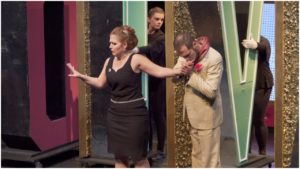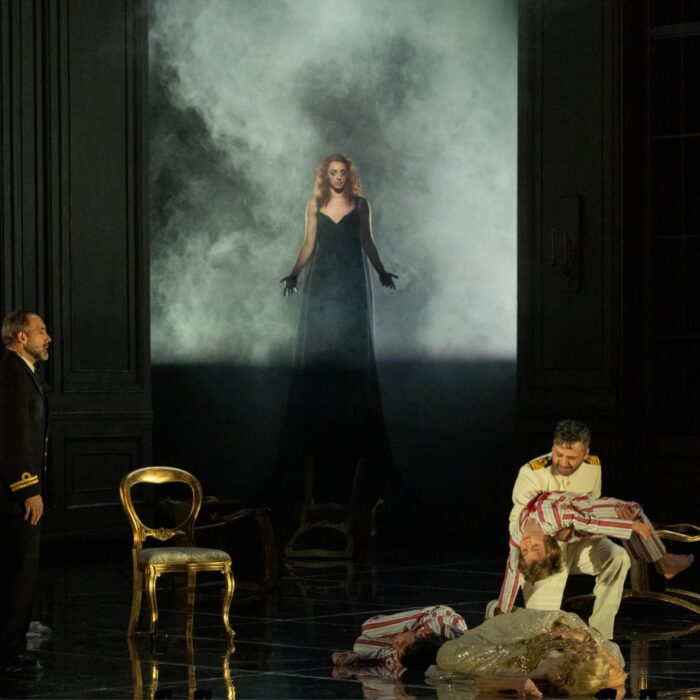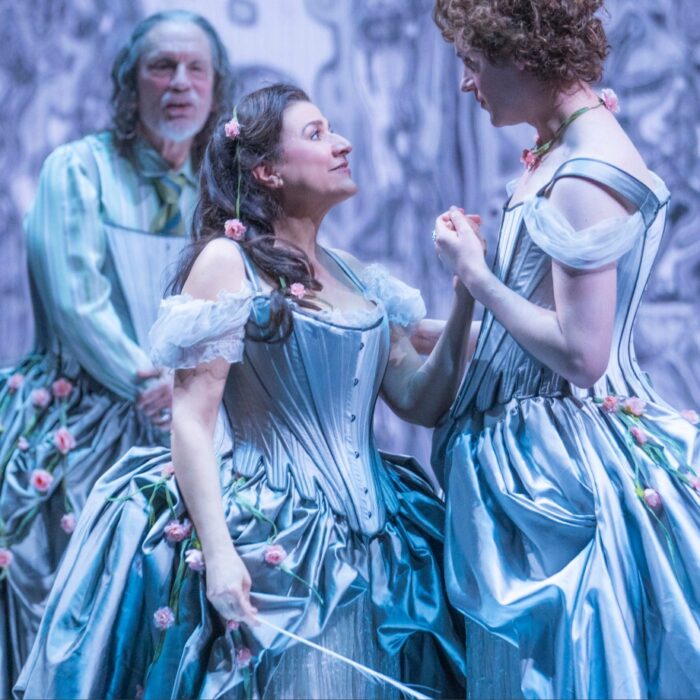
Barocco Europeo Trieste 2021 Review: L’Impresario Delle Canarie
Donatella Busetto Successfully Brings Domenico Sarro’s Intermezzo To The Stage
By Alan Neilson(Photo: Mariana Moreira)
The first setting of Metastasio’s first major libretto, “Didone Abbandonata,” was set to music by Domenico Sarro and premiered at Naples’ Teatro San Bartolomeo in 1724. Less well known is the accompanying intermezzo “L’Impresario delle Canarie,” also by Metastasio with music by Sarro, which shared in the evening’s success. The work is in two parts, with the first part performed between Acts one and two, and the second part between Acts two and three.
It is a typical buffo piece, with a shallow plot, but which allows for amusing moments. The prima donna Dorina is pursued by the impresario Nibbio, ostensibly for business purposes, but also for romantic reasons, which she cleverly manages to sidestep. Eventually, to get rid of him she lists an outrageous set of demands, including chocolates, coffee, ice cream, and two presents a week. Nibbio, however, agrees, much to her shock, and the work ends without a resolution.
Metastasio, however, turned it into a criticism of shabby artistic habits, with Dorina giving voice to the librettist’s views, while Nibbio defends the art form as it then currently stood, and in the process presents himself as somewhat uncultured and foolish, believing that the texts are not at all important, as the audience cannot follow them in any case.
Although Metastasio wrote many texts for the stage during his career, this was to be his only buffo libretto.
This production of “L’Impresario delle Canarie” at the Teatro Rossetti in Trieste was presented by Barocco Europeo, an organization promoting baroque music, including the performance of intermezzi, with the Cenacolo Musicale Ensemble, under the direction of Donatella Bussetto, providing the orchestral accompaniment. The presentation was divided into two parts as originally envisaged, but on this occasion divided and preceded by a short sinfonia, both by Nicolà Porpora.
Strong Direction With Excellent Student Support From The Accademia di Belle Arti di Venezia
The director Cesare Scarton took the decision to update the drama to the present day, and with a plot that is essentially not time specific, it could have been set at any time in the last 400 years and been equally effective. He was supported by the students of the Accademia di Belle Arti di Venezia who were given responsibility for scenography and costume design. They successfully produced an imaginative, functional, and visually pleasing set, which was also used to highlight the character of Dorina. Four large colorful letters on wheels, surrounded by lights, which when arranged in the right order spelled out the word DIVA dominated the stage. The letters were also designed so they could become seats, pillars, or even a sort of trolley which Nibbio used to propel himself across the stage. It all added to the energy and general sense of comedy, and the stagehands, also students, became part of the drama as they took on the role of servants or simply watched on, intrigued by the behavior of the Impresario and the Diva.
The work contains five arias, three for Dorina and two for Nibbio, and two duets. There is, therefore, a considerable amount of recitative, which can easily become dull and undermine any sense of comedy, if they are not performed well. It was essential that the singers presented them in a lively manner, hamming up their comedy potential, and integrating them into their characters, whilst at the same time ensuring their acting supported and reflected the spirit of the drama. Cesare’s direction in this respect was excellent. Along with the two singers who were attentive to every word, every nuance in each other’s behavior, he crafted two easily recognizable stereotypes so that the audience was able to identify their characters very quickly. There was also a natural spontaneity that existed between them which added to the ease with which the drama was able to flow.
A Real Diva In Action
Soprano Martina Barreca was cast in the role of Dorina and put in an excellent performance. She fully engaged with the character and played up the comedy for all it was worth, portraying her character as the typical diva, in which she successfully coated her underlying emotions with humor. Her facial expressions were a show on their own, and her comic timing was spot on. The arias and duets were not particularly demanding, but she sang them confidently and well. Her first aria was particularly pleasing in which she showed off her vocal control, and ability to gently ornament the vocal line with short trills and short coloraturas, which sent Nibbio to sleep. It was her ability to deliver recitatives, however, which really impressed. She constantly introduced accents, indulged in mimicry, and colored her voice in order to send up her character.
A Persistent Impresario
Nibbio was played by baritone Michele Soldo, who proved to be the perfect match for Barreca’s Dorina, which was particularly well illustrated by the duet which brings the first part to a conclusion, in which he was knocked to the ground by Dorina who was not impressed by the flowers he gave her. His singing was clear, confident, and expressive. His second aria was nicely rendered and showed off his easy, lyrical manner to good effect, which he deliberately made overly earnest to inject a degree of humor. Recitatives were also delivered with confidence and articulated with the skill to bring out his over-the-top attempts at persuading/seducing Dorina. He engaged naturally with the work’s sense of fun, and having him riding around in the letter D like a knight on his charger was very amusing.
A Balanced Performance From The Ensemble
The Cenacolo Musicale Ensemble, directed by Busetto from the harpsichord, comprising two violins, viola, cello and double bass produced a vibrant performance that promoted the onstage drama and produced the necessary support to the singers. The inclusion of the two Porpora sinfonie, nos 1 and 2, were given elegant, dignified performances which contrasted effectively with the intermezzo, and brought a nice sense of balance to the evening.
Overall, it all made for a light, enjoyable piece of theater, and gave the audience a rare opportunity of seeing a staged performance of an intermezzo, a theatrical form that has been largely overlooked since it went out of fashion in the mid-eighteenth century.



